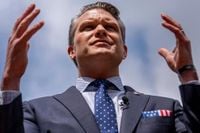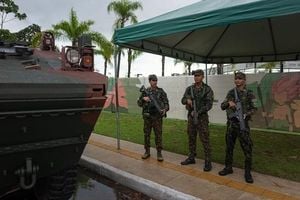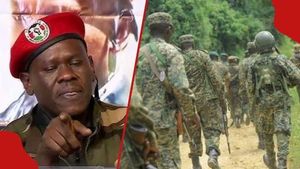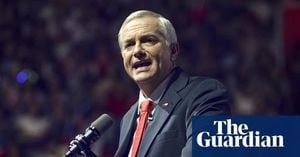Hundreds of the United States’ most senior military leaders have been ordered to assemble at Marine Corps Base Quantico, Virginia, for a sudden and secretive meeting on Tuesday, September 30, 2025—a move that has sent shockwaves through the Pentagon and beyond. The directive, issued by Defense Secretary Pete Hegseth, applies to nearly every general and admiral with command responsibilities worldwide, from those overseeing troops in active conflict zones to leaders stationed across Europe, the Middle East, and the Asia-Pacific region. The reason for the gathering remains undisclosed, fueling anxiety and speculation throughout the ranks of the U.S. military and among lawmakers on Capitol Hill.
According to The Washington Post and corroborated by CBS News and Fox News, the order was delivered earlier this week, catching even seasoned commanders off guard. In total, about 800 generals and admirals—along with their top enlisted advisers and a handful of lower-ranking aides—have been summoned, potentially pushing the total number of attendees beyond 1,000. The unprecedented scale and secrecy of the event have left many scrambling for answers. As one military source told The Washington Post, “People are very concerned. They have no idea what it means.”
The Pentagon has offered little solace. Chief spokesman Sean Parnell confirmed only that Hegseth “will be addressing his senior military leaders early next week,” declining to elaborate on the agenda or rationale. This lack of transparency has led to widespread speculation, with some insiders warning that assembling so many high-ranking officers in one place could pose a grave national security risk. “You don’t call [general and flag officers] leading their people and the global force into an auditorium outside D.C. and not tell them why/what the topic or agenda is,” another official told The Washington Post. “Are we taking every general and flag officer out of the Pacific right now? All of it is weird.”
Further complicating matters, the meeting comes at a moment of significant upheaval within the Defense Department. Since taking office, Secretary Hegseth has moved aggressively to reshape the military’s leadership structure. As reported by Fox News and CBS News, Hegseth has ordered the firing of about 100 generals and admirals, mandated a minimum 20 percent reduction in four-star officers across both the active-duty military and the National Guard, and called for an additional 10 percent cut to the overall number of generals and admirals. He’s described these moves as part of his “less generals, more GIs policy,” arguing that the current ratio—one general to every 1,400 troops—is far out of step with historical norms. “We won World War II with seven four-star generals,” Hegseth said in February, as quoted by CBS News. “Today, we have 44. Do all of those directly contribute to warfighting success? Maybe they do, I don’t know, but it’s worth reviewing to make sure they do.”
The secretary’s campaign to streamline the ranks has not been without controversy. The recent firings of Lieutenant General Jeffrey Kruse, Vice Admiral Nancy Lacore, and Rear Admiral Milton Sands—each high-profile leaders—have prompted fears of a broader purge, particularly as the dismissals have disproportionately affected women and have often come without public explanation. According to The Washington Post, the Trump administration has also removed the chairman of the Joint Chiefs of Staff, Gen. Charles Q. Brown Jr.; the chief of naval operations, Adm. Lisa Franchetti; the commandant of the Coast Guard, Adm. Linda Fagan; and the Air Force vice chief of staff, Gen. James Slife, among others. The cumulative effect has been to sow confusion and unease throughout the upper echelons of the military, with some officials questioning whether such moves risk eroding the Defense Department’s longstanding reputation for political neutrality.
The timing of the Quantico meeting has only heightened tensions. It falls just one day before a possible government shutdown on October 1, 2025—a deadline that, if missed, would delay paychecks for military personnel even as they remain on duty. As CBS News notes, the uncertainty around government funding has further complicated logistics, with some commanders worried they or their staff could be stranded away from their posts if the shutdown occurs.
Meanwhile, speculation is swirling about what Hegseth intends to discuss. Some believe he may use the occasion to unveil the new National Defense Strategy, a document released every four years that lays out the Pentagon’s priorities. This year’s strategy is expected to shift focus toward homeland defense, with additional emphasis on operations in the U.S. Southern and Northern Commands. Others, however, are skeptical that such a sweeping and secretive gathering would be necessary for a policy rollout. One official, speaking to The Washington Post, dismissed the idea: “You’re not pulling out everyone in the room to bring them over to say, ‘Stop painting your nails because we’re a war-fighting organization.’”
On Capitol Hill, lawmakers from both parties appeared blindsided by Hegseth’s order. Leaders of the Senate and House Armed Services committees declined to comment immediately, underscoring the surprise and uncertainty the directive has generated. The lack of communication has also left many military families and subordinate officers in the dark, with some expressing concern about the disruption to ongoing operations and the potential vulnerability created by removing so many commanders from their posts, even temporarily.
The White House, for its part, has attempted to downplay the meeting’s significance. President Donald Trump told reporters on September 25, “I love it. Let them be friendly with the generals and admirals from all over the world. Is there something wrong with it?” Vice President JD Vance echoed this sentiment, telling the press, “It’s not particularly unusual that generals are speaking with Hegseth. I think it’s odd that you guys have made it into such a big story.”
Yet, for many within the military, the combination of abrupt leadership changes, the looming threat of a government shutdown, and the unprecedented nature of the Quantico meeting have created a sense of foreboding. As one defense official put it, “It will make the commands just diminished if something pops up.” Others have raised concerns that the secretary’s efforts to scrutinize promotions and review officers’ social media histories could drive talented leaders out of the service, undermining morale and the military’s ability to remain insulated from political pressures.
Amid all the speculation, one thing is clear: Tuesday’s gathering at Quantico marks a turning point for the Pentagon. Whether it signals a new era of reform, a further politicization of the armed forces, or something else entirely, the nation’s top military leaders—and the American public—are watching closely to see what comes next.





